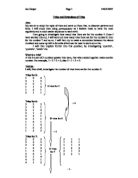I will check my hypothesis, that ‘’the pattern is the same for every non –leap year’’ by checking another non – leap year, 2001.
Ex 1.4 Results for 2001
The matching months are:
1, 10 = same
2, 3, 11 = same
4, 7 = same
5
7
8
9, 12 = same
As you can see, once again the results for the months that start on the same day show the same pattern as in Ex1.1 and Ex1.3. This clearly shows that there is indeed a pattern between the start days of the months each non – leap year.
2Exploring the relationship between numbers in columns of the calendar
Ex 2.1 First column in January
The difference in date is always 7 when descending.
To find the expression in terms of n, I first multiply the term number ( n ) by 7, which gives: 7 14 21 28 35
This is 4 more than required each time, so subtract 4 to correct the sequence. Therefore, the expression is:
n = 7n – 4
I decided to test my expression on some other columns in the calendar. First, I test another column from the same month, January, and then the second in July and the sixth in December.
Ex 2.2 – Seventh column in January
As you can see from the table above, the difference is 7 again. The formula here is n = 7n - 5
Ex 2.3 – Second column in July
The above table shows that the formula is n = 7n – 2
Ex 2.4 – Sixth column in December
The above table yields the formula n = 7n – 4
It is interesting to note that in the sixth column the formula was n = 7n – 4 and that in the seventh column the formula was n =7n –5. However, since the second column was n = 7n – 2 this means there is obviously not a pattern of the n = 7n – x being directly related to which column it’s in.
Conclusion of Ex 2: I have noticed that generally, all columns are n = 7n – x where x varies with the start date. The formula exists in this form because the columns with which it deals represent weeks, which consist of 7 days, 7 being the all important number.
3. Exploring the relationship between numbers in the rows
Now I explore the horizontal numbers…
Ex 3.1 The first row in June:
The formula is obviously n = n here, but will it change in the next few rows?
Ex 3.2 The second row in June:
As you can see from the table above, the formula is quite simple:
n = n + 5
Ex 3.3 The third row in June:
The above table gives another formula: n = n + 12
Ex 3.4, Finally the fourth row in June:
The final formula is n = n + 19
Ex 3.5:These are the formulae for the rows in the month of June:
First row: n = n
Second row: n = n+5
Third row: n = n+12
Fourth row: n = n+19 I didn’t draw the table for 5th, but predict it as:
Fifth row: n = n+26
The general expression is n = n + x depending on the start date.
4. Studying diagonal relationships
Ex 4.1 Diagonally descending to the left, starting with 2nd January.
The difference is always 6. n x 6 gives the sequence:
6 12 18 24 30, but to get the correct sequence subtract four:
n = 6n – 4
I will test the formula on 2 other diagonals descending to the left: one more January, one July.
Ex 4.2: Diagonally descending to the left, starting with 9th January.
The above table gives the formula n = 6n + 3
Ex 4.3: Diagonally descending to the left, starting with 5th June.
This table gives the formula n = 6n - 1
Now I will study Diagonals descending to the right, to examine whether there is any similar relationship between these numbers. I chose to begin with the date 3rd February.
Ex 4.4 Diagonally descending to the right, starting with 3rd February.
I notice from the above table that the difference between the terms is always 8. Multiply each n number by 8 and you get:
8 16 24 32. However, this is not quite right, so to get the correct expression, subtract 5. The expression is:
n = 8n – 5
This is because you increase by 1 week + 1 day as you go down diagonally to the right. I will test another two diagonals descending to the right.
Ex 4.5 Starting June 6th
The above table gives the expression 8n – 2.
Ex 4.6 Starting July 4th
The above table gives a formula of 8n – 4.
I have noticed that descending diagonally left is always n = 6n – x,where x depends on which date you choose to start with. This formula makes sense because when you descend diagonally to the left, you travel foreword in time by one week minus a day, i.e. by six days. I have also noticed that descending down (i.e. Columns) is always n = 7n – x; and that descending diagonally right gives n = 8n – x.
5. Studying relationships between adjacent numbers
I drew a box around 4 numbers:
Ex 5.1 Starting 2nd August
- 3 2 x 10 = 20
9 10 3 x 9 = 27
The difference is 7. I found that this applies to any box of 4 numbers on the calendar.
Ex 5.2 Starting 6th October
- 7 6 x 14 = 84
13 14 7 x 13 = 91
The difference is 7 again, as in Ex 5.1.
Ex 5.3 Starting 4th February
4 5 4 x 12 = 48
11 12 11 x 5 = 55
Yet again, the difference is 7, a number which seems often to occur in my calculations, no doubt due to the fact that there are 7 days a week in each calendar month.
Then I explored what happened to a box with 6 numbers.
Ex 5.4 Starting 1st February
1 2 3 1 x 10 = 10
8 9 10 3 x 8 = 24
The difference, significantly is 14
Ex 5.5 Starting June 2nd
2 3 4 2 x 11 = 22
9 10 11 4 x 9 = 36
The difference is 14 again. This strongly suggests a pattern.
Now I decided to examine what happens when I have 6 numbers in the vertical, instead of 6 numbers horizontal.
Ex 5.6 Starting 1st June
Ex.5.7 Starting 5th October
Now I will expand the box to 8 numbers:
Ex.5.8 Starting 1st February
Ex.5.9 Starting 6th July, vertical box
Now I decided to try a box with 9 numbers in it:
Ex.5.10 Starting 1st February:
Ex 5.11
I hypothesise that if I take any box of 9 numbers on a calendar, I will always get a difference of 28.
To test this, I chose a box 15th December
Ex 5.12
I hypothesise that if I draw a box of 10 numbers the difference will be 35.
I tested this using the 2nd July.
This was not the answer I was predicting, so I decided to try another box.
Ex5.13 A horizontal box of 10 numbersstarting 13 September:
I hypothesise that in order to get a difference of 35, I need 12 numbers in the box.
Ex.5.14 Starting 1st February
Finally, I decided to test a box of 14 numbers.
Ex.5.15 Starting 1st August
Ex.5.16 Testing a box of 16 numbers, starting 1st June.
Ex.5.17 A box of 18 numbers.
Ex.5.18 A box of 20 numbers
I decided to plot a table summarising the above results:
Note that the above table includes the 7 x table, which is once again significant as there are seven days a week. Therefore, there is a relationship between the figures involved in calendar calculations.
However, I must comment on this last table, Ex 5.19– it’s odd that certain numbers you would logically expect to be in the sequence are not present, as you never get the numbers 35, 49, 56 or 77. All these numbers are multiples of 7, and yet they do not follow an orderly sequence as you increase after 9 figures in a box: the pattern is not regular. I am unable to work out why this is so.
Areas of possible further work
I could have explored the following:
- Division of diagonals, but this would be difficult because they would not be whole numbers.
- Addition or subtraction of diagonals in boxes, e.g.
1 2 1 + 9 = 10
8 9 2 + 8 = 10
- Addition of columns, adding rows, e.g.
1 + 8 + 15 + 22
- A write up of whether the last day of each month follows the same pattern as the first month, in each year except leap years, i.e. an investigation similar to that of Ex 1.







